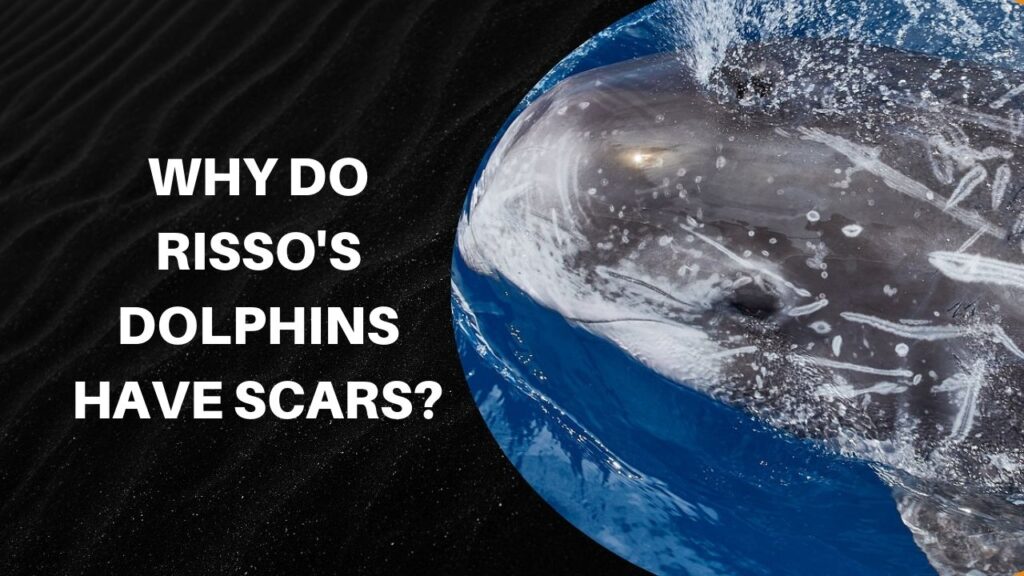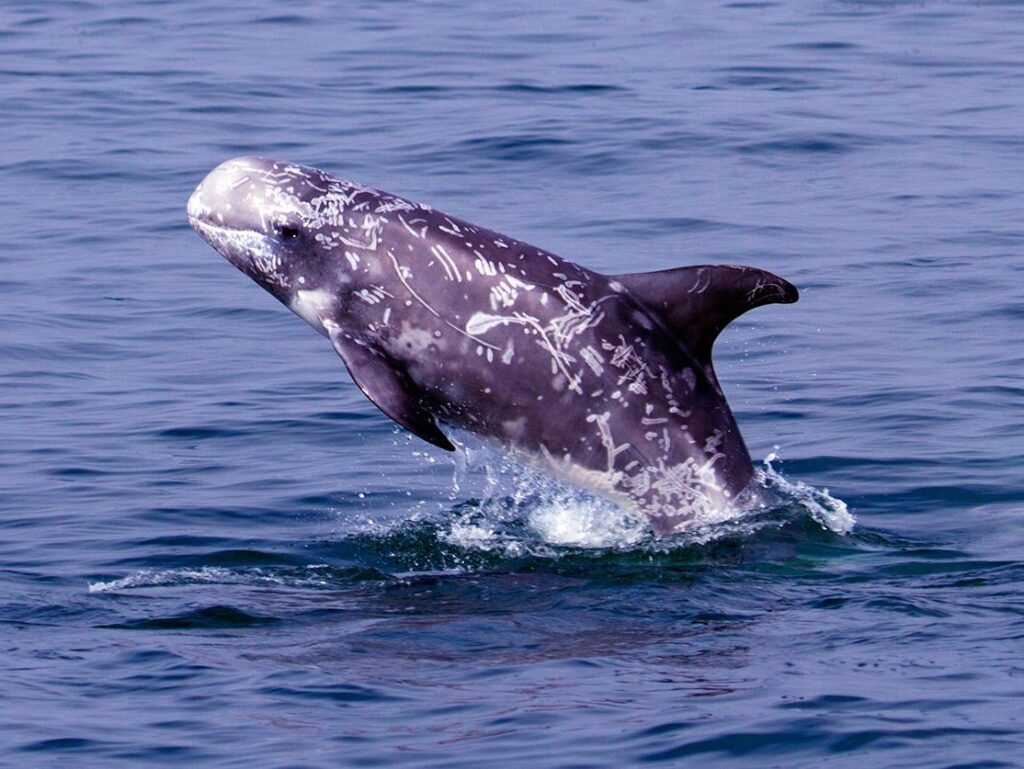
Why Do Risso’s Dolphins Have Scars? Risso’s dolphins have scars due to aggressive interactions with other dolphins and their prey.
Risso’s dolphins, also known as Grampus griseus, are a species of dolphins found in oceans worldwide.
With their massive dorsal fin and stocky physique, these amazing animals are distinguished by their unusual look.
But what attracts the interest of many onlookers are the noticeable scars on their bodies. These dolphins’ aggressive contact with other dolphins and their prey has left them with scars.
The main food source for Risso’s dolphins, squid, is the object of their specific eating behavior. Squids retaliate against the dolphins during these fierce hunting sessions, leaving wounds on their bodies.
Furthermore, the dolphins socialize a lot and may sustain scars from hostile confrontations with other dolphins in their group.
These wounds are evidence of the lively and occasionally aggressive lifestyle that Risso’s dolphins lead. [Why Do Risso’s Dolphins Have Scars?]
Table of Contents
Understanding Risso’s Dolphins
The distinctive morphological traits of Risso’s dolphins, also called Grampus griseus, set them apart from other dolphin species. Their big dorsal fins, round heads, and powerful bodies define them.
Their mouths are placed vertically, so they don’t smile like dolphins do, and their skin is primarily dark gray to light gray. Additionally, these dolphins have one or more noticeable scars on their bodies, which get more noticeable as they age.
It is thought that their social activities, including encounters within their own species or with other marine animals, is what caused these scars.
Worldwide, populations of Risso’s dolphins inhabit both coastal and offshore regions of temperate and tropical oceans. [Why Do Risso’s Dolphins Have Scars?]
They are most frequently found in places with steep underwater terrain, like canyons or continental slopes, and they prefer deep waters.
These dolphins can be found in the Atlantic, Pacific, and Indian oceans, indicating their extensive geographic range.
Additionally, they have a history of seasonal migration, relocating to places with higher concentrations of their preferred prey—fish and squid, for example.
See Also: Why Bottlenose Dolphins Are Mammals? Fascinating Biology

Unveiling The Mysterious Scars
Dolphins of the Risso’s species, who are renowned for their unusual appearance and lively disposition, frequently have scars from their interactions with the deep sea.
Their bodies are often covered in scars, which have baffled experts for years about their frequency, potential causes, and current research in this field. [Why Do Risso’s Dolphins Have Scars?]
These wounds, like honorifics, might be more typical than we realize. Scars are present on many members of the species, indicating that these are not isolated occurrences. While the precise reasons are still unknown, a number of theories have been proposed.
According to one theory, the social interactions that occur among dolphin colonies are what cause these scars. When mating or competing for resources, aggressive behavior may result in permanent injury.
A further conjecture pertains to parasites or commensal organisms adhering to the skin of these dolphins. These animals have the potential to irritate or injure people, which over time may leave scars.
Scientists are investigating dolphin behavior, analyzing tissue samples, and employing cutting-edge imaging methods to try and understand the mystery behind these mysterious scars in an effort to shed light on this occurrence.
See Also: Why Are Pink Dolphins Pink? Mysteries of Nature Unveiled
Social Behavior And Scar Formation
Within their communities, Risso’s dolphins participate in a variety of social interactions, just like other social cetaceans. Their body’s creation of scars is largely influenced by these interactions.
The main purpose of the scarification that these dolphins exhibit is group communication.
The aggressive behaviors that Risso’s dolphins engage in during social interactions include bites and scratches. These actions may result in physical harm and scarring.
These scars can reveal details about the social standing or reproductive history of the dolphin and act as obvious indicators of previous interactions. [Why Do Risso’s Dolphins Have Scars?]
| Scars Formation | Communication |
| Risso’s dolphins engage in aggressive behaviors | Scars serve as visible markers of past interactions |
| Aggressive behaviors can cause physical injuries | Scars convey information about social status and reproductive history |

Implications For Conservation
The body scars that adorn Risso’s dolphins can range widely in size and intensity. The main cause of these scars is the activity and threats brought on by humans.
Because of the rise in commercial fishing and contact with fishing gear, entanglements and injuries to Risso’s dolphins are common. Gillnets and longlines, two types of fishing gear, can cause obvious scarring on their skin.
Scars can also result from boat collisions and strikes because these dolphins are known to approach boats out of curiosity. [Why Do Risso’s Dolphins Have Scars?]
In order to guarantee the preservation and defense of Risso’s dolphins, it is imperative to tackle these hazards caused by humans.
Minimizing injuries and scarring can be achieved in large part by putting into practice strategies to avoid inadvertent entanglements, such as changing fishing techniques and equipment.
Preventing collisions can also be achieved by making fishermen and boaters aware of the presence and fragility of these dolphins.
In order to maintain the habitats and general well-being of the dolphins of Risso and other marine species, conservation efforts should also concentrate on establishing marine protected zones and encouraging ethical tourism practices.
See Also: Why Is The Indus River Dolphin Endangered?
Frequently Asked Questions For Why Do Risso’s Dolphins Have Scars?
Why Are Rissos Dolphins Scarred?
The aggressive activity of Risso’s dolphins, including fighting, mating, and interacting with marine parasites or prey, has left them scarred. Dolphins may use these scars as a means of identification or communication. [Why Do Risso’s Dolphins Have Scars?]
Why Do Dolphins Have So Many Scars?
Because they play fight, protect themselves from predators, and socialize with other dolphins, dolphins often have several scars. Their social interactions and busy lifestyle cause their bodies to become scarred.
Why Do Dolphins Have Scratches On Them?
Dolphins often get scratches from interactions with other dolphins or rough surfaces in their environment.
What Is The Lifespan Of A Risso’s Dolphin?
The average lifespan of a Risso’s dolphin is at least 35 years.
Conclusion
Scars on Risso’s dolphins are a natural occurrence that may result from a number of factors. These amazing animals can be uniquely identified by these enigmatic markings that they have developed via interactions with their surroundings and other marine life.
Scientists can learn more about the fascinating behaviors and ecological relationships of Risso’s dolphins by examining these scars.
Gaining an understanding of these facets will help them in their conservation efforts and guarantee the survival of these fascinating marine animals for future generations.

Mr. Das, a certified pharmaceutical scientist, holds a Bachelor of Science in Pharmaceutical Sciences and passionately contributes to dolphin conservation as a member of the committee in Bangladesh.


